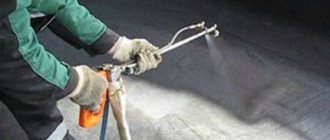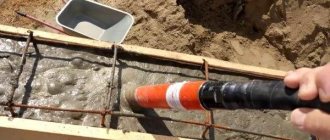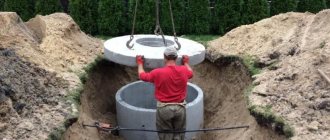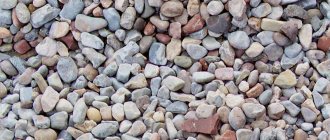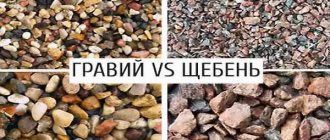Of the huge range of ready-made reinforced concrete products, concrete rings are perhaps the most common elements of well installation. The variety of standard sizes and methods of joining rings allows you to make concrete wells or horizontal communications in any soil, regardless of its mechanical properties or its saturation with groundwater.
This is an extremely robust and reliable design, as
- made from the best brands of cement;
- for the production of concrete mixtures, fillers with the best strength characteristics are used (crushed stone from granite, basalt, gabbro and similar mountain minerals);
- The presence of steel reinforcement in the structure is mandatory.
Thanks to these proven GOST characteristics, the service life of concrete rings reaches hundreds of years, and sometimes more.
Purpose and application
Rings with an internal diameter of 1000 mm, an external diameter of 1160 mm and a height of 100 to 1000 mm are the most common in the practice of casting concrete products. But their production is not limited only to these standard sizes. In the practice of constructing wells, cesspools, and septic tanks, other sizes can be used upon prior order. Thus, it turns out that these two parameters - the internal and external diameter, as well as its height - can be changed at the request of the customer. But all strength characteristics remain within the limits of GOST requirements, that is, they are mandatory.
Types of products
Ring is a conditional name; modules for wells, septic tanks or horizontal drifts for laying communications can have a cross-section different from the ring-shaped one. For example, a rectangular (square) box.
When creating wells, wall rings are used: monolithic, without any perforation. They can withstand high pressures: external from the soil and internal, filling such wells with water. Rings can be classic round or square in cross-section (these are used for installing a cellar). On the contrary, drainage rings have walls that are perforated. To prevent the elements from shifting relative to one another, locks are made at the ends of some - when the technological protrusion in one exactly coincides with a similar-shaped depression in the other.
Markings and sizes
It is most convenient to perceive data on volume, weight, diameter and other parameters in tables. Here are some data concerning not only the rings themselves, but also the reinforced concrete covers or bottoms used with them (wall thickness is not indicated, since it is clear when subtracting the internal diameter from the external one):
Table of sizes, volume and weight of rings
| Brand | Outer diameter, mm | Internal diameter, mm | Ring height, mm | Volume of concrete, m³ | Ring mass, t |
| K-10-5 | 1160 | 1000 | 490 | 0,14 | 0,35 |
| K-12-5 | 1410 | 1250 | 490 | 0,17 | 0,42 |
| K-15-5 | 1680 | 1500 | 490 | 0,22 | 0,55 |
| K-20-5 | 2200 | 2000 | 490 | 0,33 | 0,82 |
| K-7-5 | 840 | 700 | 495 | 0,084 | 0,21 |
| K-7-1.5 | 840 | 700 | 145 | 0,024 | 0,06 |
| K-7.6 | 840 | 700 | 590 | 0,3 | 0,25 |
| Ks-10-3 | 1160 | 1000 | 290 | 0,08 | 0,2 |
| Ks-10-6 | 1160 | 1000 | 590 | 0,16 | 0,4 |
| Ks-13-6 | 1410 | 1250 | 590 | 0,2 | 0,5 |
| Ks-13-9a | 1410 | 1250 | 890 | 0,28 | 0,7 |
| Ks-13-9b | 1410 | 1250 | 890 | 0,24 | 0,6 |
| Ks-10-9 | 1160 | 1000 | 890 | 0,24 | 0,6 |
| Ks-15-9 | 1680 | 1500 | 890 | 0,4 | 1,0 |
| Ks-15-6 | 1680 | 1500 | 590 | 0,265 | 0,66 |
| Ks-20.6 | 2200 | 2000 | 590 | 0,39 | 0,98 |
| Ks-20.6a | 2200 | 2000 | 590 | 0,3 | 0,75 |
| K-10-10 | 1160 | 1000 | 990 | 0,27 | 0,68 |
| K-12-10 | 1410 | 1250 | 990 | 0,33 | 0,82 |
| K-15-10 | 1680 | 1500 | 990 | 0,44 | 1,1 |
| K-7-10 | 840 | 700 | 990 | 0,17 | 0,42 |
For all these sizes, covers that perfectly match them can be cast, and in them there are holes with sockets for standard plumbing hatches (with cast iron or steel groove rings). Or holes of a different diameter.
| Brand | Outer diameter of the cover, mm | Diameter of the hole in the cover, mm | Cover thickness, mm | Cover weight, t |
| 1PP15 | 1680 | 700 | 150 | 0,69 |
| 1PP20 | 2200 | 700 | 160 | 1,37 |
| 1PP20-1 | 2200 | 700 | 160 | 1,38 |
| 2PP25 | 2700 | 700 | 180 | 2,4 |
| 2PP8 | 1000 | 800 | 170 | 0.33 |
| 2PP-15-1 | 1600 | 700 | 150 | 10,68 |
| 2PP-20-1 | 2200 | 700 | 160 | 1,31 |
| 3PP-15-1 | 1680 | 1000 | 150 | 0,53 |
| 3PP-20 | 2200 | 700 | 160 | 1,34 |
| KCP-1.20N | 2200 | 700 | 160 | 1,28 |
| KCP-1.25N | 2700 | 700 | 180 | 2,31 |
| PVG-15 | 1720 | 700 | 140 | 0,68 |
| PVG-20 | 2240 | 700 | 160 | 1,43 |
| PK-15 | 1720 | 700 | 140 | 0,68 |
| PC-15-10 | 1720 | 1000 | 140 | 0,52 |
When constructing drinking water wells or septic tanks, an important detail of such structures will be a cast concrete bottom with reinforcement inside that matches the profile of the ring (or rectangular box).
Sometimes, with such installation, the rings and bottom are cast with locks that match in shape. This allows you to maintain the integrity of the structure even in seismic zones, and prevents the well elements from deforming in quicksand soils, as happens in geological deposits of different densities. Data table on types of bottoms for wells:
| Brand | Diameter, mm | Thickness, mm | Volume of concrete, m³ | Bottom mass, t |
| PN-25 | 3000 | 140 | 0,98 | 2,45 |
| PN-20 | 2550 | 120 | 0,59 | 1,48 |
| PN-15 | 2000 | 120 | 0,38 | 0,95 |
| PN-10 | 1500 | 100 | 0,18 | 0,45 |
| PN-7 | 840 | 100 | 0,12 | 0,09 |
Thus, to correctly read the symbols according to GOSTs, you need to keep in mind that the letter index KS means that this is a wall model.
The designation KLK means “ring for drainage and/or storm sewerage.” KVG is produced as the outer shell of water supply communications and gas pipelines, KFK - for drainage systems and network collectors, and the letters KO are placed on the support rings of well foundations. The marking on the ring means the following:
- Diameter. The first digit of the marking, the value in decimeters, indicates the internal diameter (from 7 to 20).
- Height. For standard height products it is not indicated. If the height is different from the standard one, it is indicated with the next digit in the numerical index. For example, KS-7-4.5 means “a wall ring with a diameter of 7 decimeters and a height of 4.5 decimeters.”
- The marking may contain additional parameters. Such as the degree of permeability of the material. The letter N means normal, P means low, and the symbol O means especially low.
The mass of the lids, bottoms, and their thickness are directly related to the size of the rings and the thickness of their walls.
But with all the variety of standard sizes, you can always select installation elements with a margin of safety.
How to check the size of rings for a well according to GOST
Choosing a well ring manufacturer is usually a headache. There are usually several manufacturers of different sizes. Who to give preference to? You can collect reviews from your neighbors and choose a couple of manufacturers. Then it’s worth driving around and seeing with your own eyes, because “normal quality” is different for everyone. What to look for and how to inspect well rings? This is how the same GOST defines verification.
Measurements are taken along two perpendicular diameters. This means that one of the points is selected. The second one will be located opposite it, and the other two will be located perpendicular (a straight line drawn at an angle of 90° - as in the figure).
How to check the size of a concrete ring for a well
- At four points, located in pairs opposite each other, the wall thickness is measured. Moreover, it is advisable to check this parameter from below and from above. If the rings are locking, check the parameters of the tenon/groove - they must match. And it is also necessary to control both from above and from below.
- Also at four points, check the height of the ring.
Plates and rings are checked using the same method. Four points are selected - two on perpendicular lines and measurements are taken at them. The measured values must match. Permissible deviations are no more than 1.5%.
Description of technology
In most cases, these products are cast from a concrete mixture in which cement of a grade of at least “300” is used as a binder. In the formwork, made according to the future shape of the ring, a slightly smaller structure made of reinforcement, connected with soft steel wire or welded, is first installed. Rods are brought out, which are bent into a loop, or ready-made “ears” - this element will later serve both for lifting and installation of the finished product by a truck crane or manipulator at the place of use, and for welding with the same element, if there are two or more rings . This welding will provide additional rigidity to the well structure.
When the concrete solution is poured into the formwork, it is compacted using a vibrator, and after the concrete hardens and is removed from the formwork, the structure is kept for at least 7 days for 50% completion. The complete readiness of the product occurs only after it has been stored for 28 days. Therefore, during mass production, they are stored in separate batches according to the days of release.
Calculation of the amount of concrete for the ring
When determining the parameters for the manufacture of rings, you should first calculate the cost of production of these products. And for this you need initial data:
- How much concrete mixture will be required to make the ring itself, the concrete bottom and the lid for the well;
- Consumption of reinforcing bars and finished reinforcing mesh for well elements.
To calculate the required amount of concrete mixture, you need to write down the parameters of the ring you need. Having in hand the cost of the cement-sand-gravel mixture, it will be possible, by adding the cost of work to these data, to calculate the price that is acceptable to you. So:
We have the outer diameter of the ring D, height h and wall thickness t.
- Using the outer diameter, we calculate the area of the outer circle using the formula (¼ π D²), where D means the outer diameter, and we take 3.14 as the value of π (without the following decimal places in the period, they are unimportant).
- Convert the numbers to meter values.
- Using the specified formula, taking into account the wall thickness, the internal diameter of the element is calculated.
- From the numerical value of the circumference area D of the outer circle, subtract the area of the circle d of the inner one.
- To determine the volume of concrete mixture with such numerical values, the height of the structure is multiplied by the area.
Calculation example
Let's say we need to calculate the volume of concrete to fill a ring with an outer diameter D=1200 mm, height h=1000 mm and wall thickness t=80 mm.
- Find the area of the outer circle. Sn=¼ π D²=1/4*3.14*1.2²=1.13 m²;
- To find the internal diameter, you need to subtract the wall thickness multiplied by 2 from the external diameter. d=D-2t=1.2-2*0.08=1.04 m;
- Calculate the internal area. Sin=¼ π d²=1/4*3.14*1.04²=0.85 m²;
- The area of our ring. S=Sn-Sin=1.13-0.85=0.28 m²;
- Volume of our product. V=S*h=0.28*1=0.28 m³.
Using an online calculator
The main rule of calculations with this useful device is to enter the numerical values of the diameter, height of the ring and the thickness of its walls indicated in the above formula, and at the same second you will be provided with a calculation of the volume of concrete needed for the manufacture of concrete elements.
Polymer sand hatches
| No. | Name | Outer diameter (mm) | Int. diameter (mm) | Load | Price ₽ |
| 1. | Polymer-sand hatch (1t) | 750 mm | 700 mm | 1000 kg | 1000 ₽ |
| 2. | Polymer-sand hatch (3t) | 750 mm | 700 mm | 3000 kg | 1000 ₽ |
| 3. | Polymer-sand hatch (6t) | 750 mm | 700 mm | 6000 kg | 1500 ₽ |
| 4. | Concrete hatch (tablet) | — | — | — | 700 ₽ |
Advantages and disadvantages of reinforced concrete rings
Typically, ring structures are installed underground. Features of the location environment may vary. This includes groundwater, critical soil pH values (excessive acidity or alkalinity), and the temperature difference between the elements of the structure located in the ground and partially above the surface.
Therefore, the installation of structures made of concrete rings requires preliminary digging of a pit. This is a labor-intensive task that requires the use of specialized equipment. And since the weight of these products is rarely less than 200 kg, a crane or manipulator is also required to install and calibrate the elements of the well. So weight is one of the disadvantages of these designs.
The second “minus” is the hygroscopicity of concrete products and the need to waterproof structures made from them, especially at the joints between elements.
But the advantages of this type of product outweigh their disadvantages. The advantages include:
- Service life. With proper workmanship and the correct composition of the concrete mixture - at least half a century. In the optimal case, you can count on a service life of a century, and even more.
- Environmental friendliness. Concrete aged more than 28 days after casting does not emit any harmful substances.
- Economical. For constructing wells and septic tanks, concrete rings are the most inexpensive material in terms of price and quality ratio.
- Mechanical strength. This includes resistance to ground movements and groundwater pressure. The reserve of mechanical strength of concrete rings to such impacts is at least threefold.
- Quick installation. The weight limits for concrete rings usually do not exceed 300-500 kg. If you have a team of healthy men, in the most extreme case you can do without the use of technology. And if you have a crane, you can install a well from prefabricated elements very quickly.
- Versatility. Septic tanks, communication tunnels, drinking or sewer wells - this is an incomplete list of the uses of concrete rings.
- Easy to care for. The smooth surface of the walls inside and out makes cleaning them quick and does not require complex hand tools.
- Lock connection. Such rings have a groove at the ends on one side and a similar-shaped protrusion on the other side. Installed “floor by floor”, they practically do not require additional waterproofing. The main thing is to thoroughly clean the grooves from foreign objects and dust accumulations before installation.
- Through rings. They have flat, smooth ends. They are connected using metal fillers by welding and cement mortar at the joints. They are installed in this way in soils where there is no danger of displacement of the earth layers.
- Additional rings. They are used at well or septic tank heights that differ from standard ones.
- Filtration. Installed when constructing filtration wells. They have evenly spaced perforations over the entire surface of the walls.
- Additional designs. These are bottom and floor slabs (usually with holes for hatches).
About private sewerage schemes
Several sewerage schemes are being implemented in suburban areas. A suitable scheme is selected based on several conditions - soil parameters, terrain, seasonality of residence and the number of people permanently living in the house. Three types of septic tanks are usually built:
- Single chamber septic tank. A simple single-chamber device is used if 1-3 people live in a country house (permanently or periodically). The main disadvantage of a septic tank is that it primarily performs a storage function and is not capable of efficiently purifying wastewater. Therefore, calling a sewer truck is a frequent event in the life of owners of a single-chamber device.
- Two-chamber septic tank . If 3-4 people permanently live in a country house, the optimal way to dispose of sewage will be a septic tank with two chambers; Each of the reservoirs consists of two or three rings. For uninterrupted operation, it is necessary to comply with a set of conditions: pipe slope, waterproofing and thermal insulation. The second (overflow) well is a place for post-treatment of wastewater; The water is finally purified in the drainage area (filtration field). A two-chamber septic tank with a volume of 5 m3 can last 10-12 years without pumping.
Schematic diagram of a three-chamber septic tank Source note.taable.com


